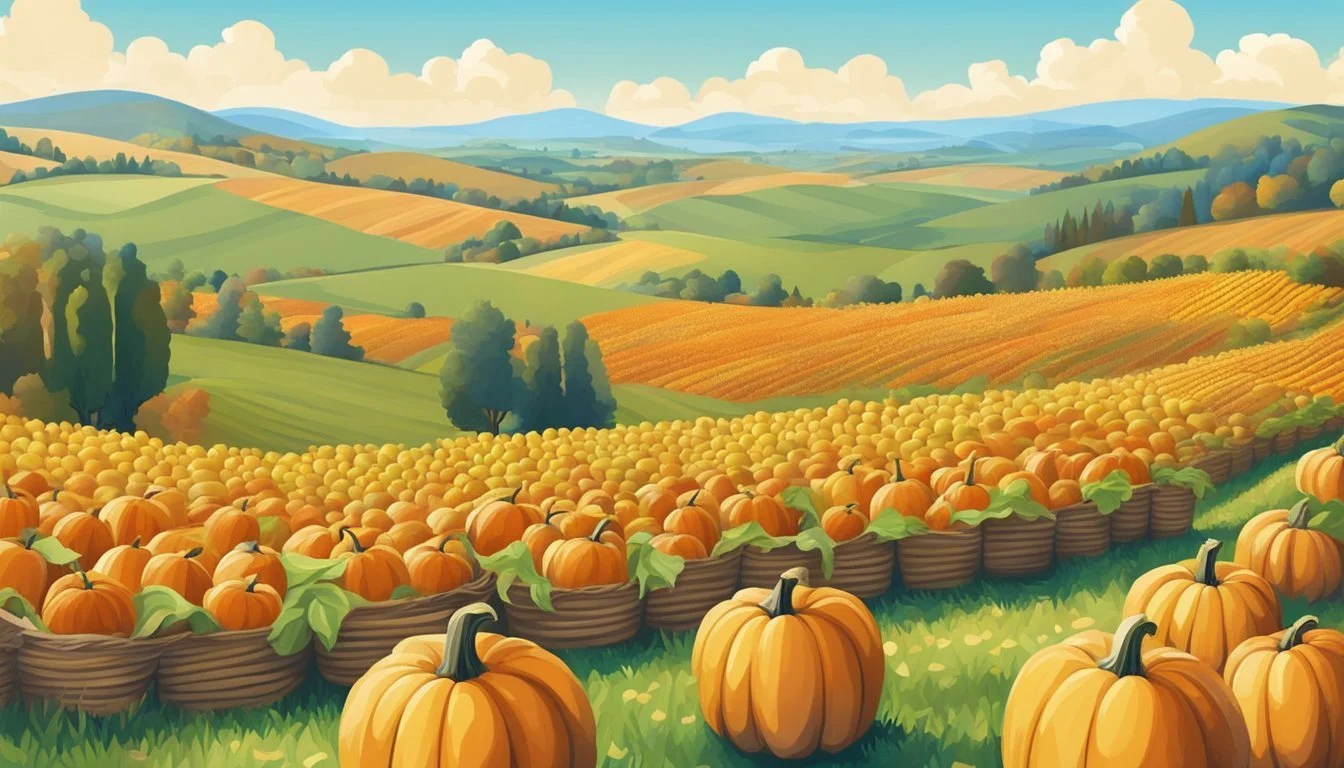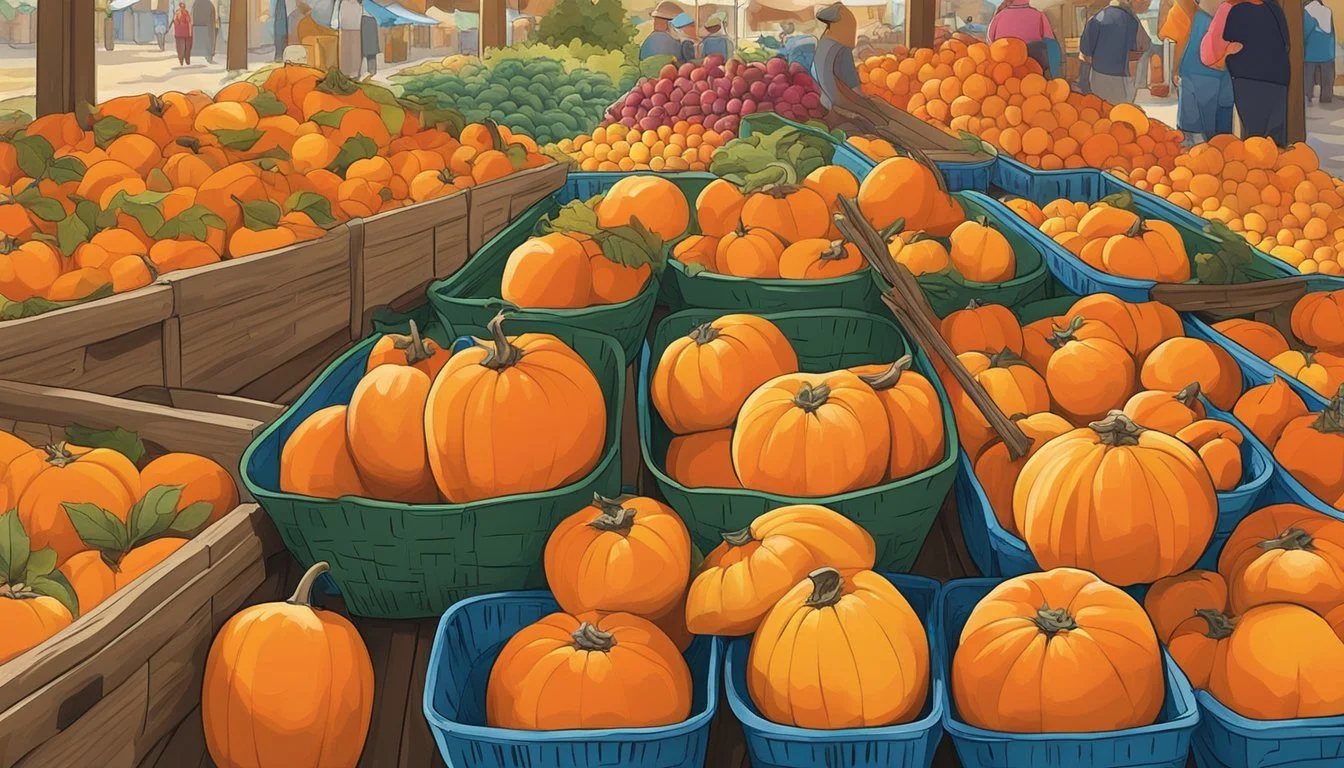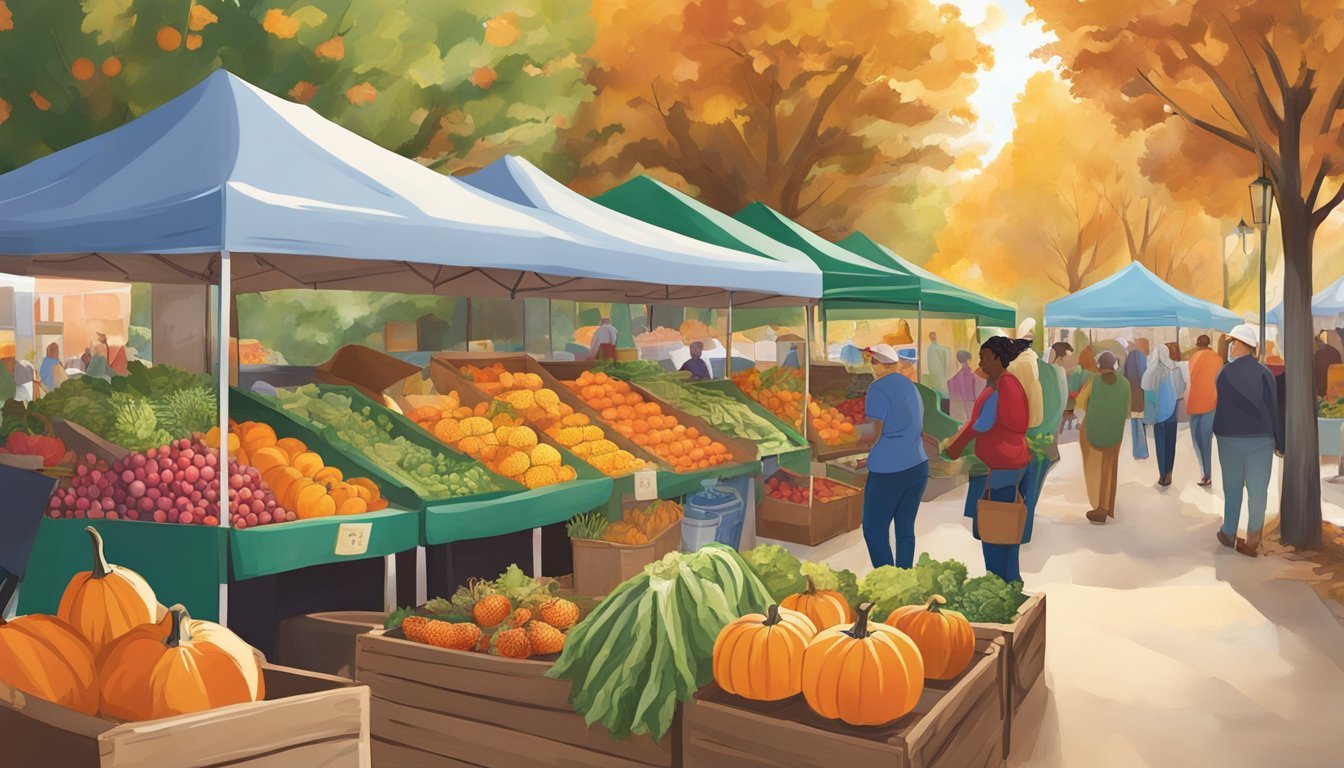South Carolina Seasonal Fruit & Vegetables in November
A Guide to Local Produce
This Article is Part of our South Carolina Seasonal Fruit & Veg Calendar
In South Carolina, November heralds a season of harvest for a range of fruits and vegetables, reflecting the state's rich agricultural heritage. During this month, the climate transitions, offering a blend of late autumnal warmth and the onset of cooler temperatures. This shift allows for a variety of produce to be available, providing local and regional consumers with fresh, seasonal options. Hearty greens, root vegetables, and late-season fruits are commonly harvested, filling market stands and encouraging seasonal culinary exploration.
The verdant fields of South Carolina yield an array of vegetables that are at their peak in November. Collard greens, a Southern staple, along with turnips, mustard greens, and sweet potatoes (What wine goes well with sweet potatoes?), are harvested and find their way into traditional dishes. Furthermore, seasonal fruits such as apples (how long do apples last?), which have been available from August, can still be found fresh, their crisp flavors encapsulating the essence of fall.
As farmers markets and groceries fill with fresh, local produce, South Carolinians often turn to these seasonal offerings for their Thanksgiving feasts and daily meals. The state's agricultural practices, which include both traditional and modern farming techniques, ensure that consumers have access to flavorful and nutritious seasonal harvests. The availability of such diverse produce throughout November not only supports local economies but also reinforces the importance of seasonality in regional gastronomy.
Overview of South Carolina's Climate and Agriculture
South Carolina's climate is predominantly subtropical, featuring mild winters and hot summers, conducive to a thriving agricultural sector that operates year-round. The state's geographical position contributes to its climate characteristics, with its location in the northern mid-latitudes, its closeness to the Atlantic Ocean, and its varied elevation due to the Appalachian Mountains' influence.
Temperature and Precipitation:
Annual average temperature ranges from the mid-50s°F in the Upstate to low-60s°F along the coast.
Precipitation is influenced by the Atlantic Ocean and the warm Gulf Stream, providing adequate moisture for crops.
Agriculture in South Carolina:
Crops are grown virtually year-round due to the state's predominantly mild climate. South Carolina’s agriculture benefits from the state's:
Long growing seasons: Extended periods of warmth allow for multiple planting and harvesting cycles.
Diverse terrain: From lowlands to upland regions, different areas support a variety of crops.
Key Farming Data:
The state is a top producer of peaches, and supports a broad spectrum of fruits and vegetables that can be harvested in November, such as:
Fall Harvest Sweet potatoes Collards Mustard greens Turnips Apples
South Carolina's agriculture is also buoyed by programs like the Climate Smart Commodities Program, which aims to enhance the sustainability of crop production in the face of climatic changes, ensuring the resilience and continuity of the state's agricultural output.
Harvesting Season in South Carolina
In South Carolina, November marks a transitional period in local agriculture as farmers wrap up the fall harvest and begin preparations for the winter season.
Fall Harvest
During November, South Carolina farmers harvest a variety of produce. Fall harvest includes the tail end of warm-season crops and a full range of cool-season crops.
Vegetables: Key vegetables harvested include:
Sweet potatoes
Turnips
Collards
Mustard greens
Radishes
Fruits: Less common in fall, but farmers may still gather late-season fruits such as:
Apples
Persimmons
Winter Preparation
As winter approaches, farmers shift their focus from harvesting to preparation. This includes:
Planting: Cultivation of crops that will endure the cooler temperatures, such as:
Garlic
Onions
Various cover crops to enrich the soil for spring.
Maintenance: Ensuring that perennials and soil are protected against the impending cold weather. This can involve:
Mulching
Greenhouses setup or repair for temperature-sensitive plants.
Farmers take these steps to protect their crops and farms from the winter weather, ensuring a robust start for the upcoming spring season.
Seasonal Fruits in November
November in South Carolina offers a diverse array of fresh produce with fruits taking a spotlight due to their variety and availability even as the weather cools.
Tree Fruits
Apples: South Carolina's November apple harvest allows for a variety of apples to be available. Fuji and Pink Lady apples are particularly noted for their late harvest.
Persimmons: The persimmon is another seasonal fruit, with its sweet and slightly tangy flesh making it a favorite for many during the fall months.
Berries
Though berries are generally associated with summer and early fall, some berry farms might extend their season with the help of greenhouses or everbearing varieties that persist into early November. Availability can be limited and is highly dependent on specific local conditions of the season.
Citrus Fruits
While not widely known for citrus fruits, some regions in South Carolina might have limited harvests of certain types of citrus fruits in November. However, these are usually not the mainstay of the fruit selection and may be more of a novelty.
Seasonal Vegetables in November
November in South Carolina offers a rich palette of seasonal vegetables that thrive in the cooling temperatures. This time of year, the state’s agricultural output includes hearty root vegetables, a diverse array of winter squash, nutritious leafy greens, and robust cruciferous vegetables. These categories harbor nutritional powerhouses perfect for autumn recipes.
Root Vegetables
Root vegetables harvested in November are known for their ability to impart earthy flavors and satisfying textures to dishes. Noteworthy mentions include:
Onions: A versatile vegetable, providing the foundational flavor for numerous recipes.
Sweet Potatoes: Rich in vitamins and sweetness, ideal for both savory and dessert dishes.
Turnips: Offering a slightly peppery taste, turnips can be mashed or roasted.
These subterranean crops are excellent for storing through the winter months.
Winter Squash
November sees a variety of winter squash reaching maturity and ready for harvest:
Butternut Squash: Creamy and sweet-tasting, perfect for soups and purees.
Acorn Squash: With a distinct shape and a nutty flavor, it's ideal for baking.
Hubbard Squash: Larger in size, suitable for pies and roasted dishes (What wine goes well with roasted dishes?).
Each type of winter squash can be prepared in myriad ways, adding color and flavor to the seasonal table.
Leafy Greens
Leafy greens in November are at their peak, offering a rich source of vitamins and minerals:
Collards: A southern staple, hearty and full of nutrients.
Kale: Known for its dense nutritional content and versatility in dishes.
Mustard Greens: They bring a spicy kick to salads, soups, and sautéed dishes. (What Wine Pairs Best with Sautéed Dishes)
These greens provide not only health benefits but also vibrant hues to any plate.
Cruciferous Vegetables
Cruciferous vegetables favored during this time are lauded for their health benefits:
Cabbage: With varieties suitable for fermenting into sauerkraut or adding crunch to slaws.
Cruciferous vegetables are known for their cancer-fighting properties and can withstand the cooler weather, making them ideal for November harvests.
Monthly Guide to Seasonal Produce
In November, South Carolina's agricultural abundance continues with a variety of produce reaching peak ripeness, offering rich flavors that are synonymous with the fall season.
November Specifics
Fruits:
Apples: Varieties like Granny Smith and Red Delicious are crisp and flavorful.
Persimmons: Native persimmons are typically ripe, adding a sweet, honey-like flavor to dishes.
Vegetables:
Sweet potatoes: Their earthy sweetness is at its peak.
Collard greens: These leafy vegetables are tender and ideal for traditional Southern dishes.
Turnips: Both roots and greens can be used, offering a potent combination of earthy and sharp tastes.
Transitional Crops
Vegetables:
Broccoli (how long does broccoli last?): It remains available, capturing its best flavor after a light frost.
Brussels sprouts: They become sweeter and more delicious as the weather cools.
Cauliflower: This vegetable is versatile and excellent for various autumn recipes.
These items represent just a fraction of the locally grown produce available in South Carolina during November, and food enthusiasts are encouraged to take advantage of this seasonal bounty.
Selecting and Storing Seasonal Produce
In South Carolina, November's bounty includes a variety of fresh fruits and vegetables that are ripe for selection. Understanding how to select and store these items ensures maximum flavor and longevity, making salads and other dishes taste their best.
Fresh Fruit: Look for fruit that feels firm and shows no signs of bruising. The skin should have a vibrant color and a natural shine. Once home, most fresh fruits benefit from refrigeration. For example, apples should be kept in a crisper drawer away from vegetables to retain their crispness and sweet flavor.
Fruit Type Selection Tips Storage Method Apples Firm, no bruises, aromatic Refrigerator, away from vegetables Pears Slightly soft at stem end Counter, then refrigerator once ripe
Fresh Vegetables: For vegetables such as broccoli and Brussels sprouts, which peak in cooler weather, look for bright green color and tight florets or compact heads. Store them in the refrigerator, ideally in a plastic bag with air holes for circulation, to maintain freshness and flavor. Greens should be rinsed, dried, and stored in an airtight container lined with a paper towel.
Lastly, for root vegetables like turnips and radishes, ensure they are firm to the touch and free from soft spots. Store them in a cool, dark place, or if cut, submerge them in water and refrigerate to keep them crisp for salads.
Broccoli & Brussels Sprouts: Store in a plastic bag with air.
Leafy Greens: Rinse, dry, store airtight with a paper towel.
Turnips & Radishes: Cool, dark place; if cut, in water in the fridge.
Using these tips, chefs and home cooks can best enjoy the vivid flavors of the season's produce while ensuring nutrients are preserved.
Local Markets and Crop Availability
In November, South Carolina's local markets are rich with a variety of fresh produce due to the state's conducive agricultural climate. Farmers markets and certified roadside markets play a pivotal role in the distribution of the season's bounty. These markets often become hubs for community interaction and support for local farmers, providing access to fresh, seasonal crops.
Market-goers can find a robust selection of vegetables during this month. The availability of crops such as collard greens, turnips, and radishes is ample, as these vegetables thrive in the cooler temperatures. Additionally, sweet potatoes and winter squash are in good supply, perfect for hearty autumn dishes.
The following list provides a snapshot of typical produce available in November at South Carolina markets:
Vegetables:
Beets (how long do beets last?)
Broccoli
Brussels Sprouts
Cauliflower
Collard Greens
Cucumbers
Kale
Mushrooms
Radishes
Sweet Potatoes
Turnips
Local markets also often feature CSAs (Community Supported Agriculture), where consumers can subscribe to receive seasonal produce directly from the farmers. This system supports local agriculture and ensures patrons receive the freshest produce available.
It's advisable for consumers to check with specific local markets or the South Carolina Department of Agriculture for the most current and detailed information on crop availability.
Recipes and Preparation Tips
November in South Carolina is a wonderful time for enjoying a bounty of fresh vegetables and incorporating them into delicious recipes. Below are some ideas and tips for making the most out of the season's produce.
Roasted Brussels Sprouts: They can be cut in half and tossed with olive oil, salt, and pepper, then roasted in an oven preheated at 400°F until they are crisp on the outside and tender inside. For added flavor, one might sprinkle them with balsamic vinegar or parmesan cheese before roasting.
Beet-Based Dishes: Beets can be transformed into an earthy and vibrant Roasted Beet Salad. Roasting intensifies their natural sweetness, and they pair well with balsamic vinegar and goat cheese. Alternatively, a Warm Kale, Quinoa, and Beet Salad is another fulfilling option that includes cooked quinoa (how long does cooked quinoa last?) for a heartier dish.
Cabbage Recipes: A staple in southern cooking, cabbage can be shredded for a simple sauté with onion and garlic, or it can be the main ingredient in a hearty Cabbage Soup, which goes particularly well with fresh thyme or rosemary.
Herbs: Incorporating seasonal herbs like rosemary and thyme into dishes enhances flavors naturally. These herbs may be used to infuse oils or to season roasted vegetables and meats.
Salads: Salads made with spinach and topped with seasonal fruits like apples provide a fresh option. One can dress such salads with a homemade Sumac Dressing, combining olive oil, sumac, and lemon juice for a tangy addition.
Salsa: For a refreshing side, one might consider making a Persimmon Salsa. The mild sweetness of persimmons complements spicy ingredients like jalapeños and onions, perfect with grilled fish or as a unique dip.
Incorporating these fresh, seasonal ingredients into recipes not only enhances the dining experience but also supports local agriculture.
Agricultural Practices and Sustainable Farming
In South Carolina, sustainable farming practices are integral to the production of seasonal fruits and vegetables in November. These practices emphasize long-term agricultural health, focusing on environmental stewardship, economic profitability, and social equity.
Crop Rotation and Diversity: Farmers often employ crop rotation to enrich soil and prevent the spread of pests and diseases. Diverse crops are planted, including seasonal vegetables, to maintain soil fertility and reduce dependency on chemical inputs.
Integrated Pest Management (IPM): This strategy combines biological, cultural, and chemical methods to manage pests with minimal environmental impact. Emphasis is on natural pest control methods to reduce the usage of synthetic pesticides.
Soil Conservation: Sound soil management practices, like cover cropping and reduced tillage, help prevent erosion and retain soil moisture—essential for November harvests.
Harvesting Techniques: When harvesting fruits and vegetables, care is taken to ensure sustainability:
Selective Harvesting: Only ripe produce is picked, which maintains plant health and ensures continuous yields.
Post-Harvest Handling: Proper techniques are crucial to preserving the quality of produce, preventing waste, and ensuring food safety.
Water Management: Efficient irrigation systems and water conservation measures are employed to sustainably manage water resources, which is crucial in the drier November climate.
In summary, South Carolina's agricultural sector is increasingly adopting sustainable farming methods. These practices not only support the environment but also enhance the quality and availability of seasonal produce during harvest months like November.









